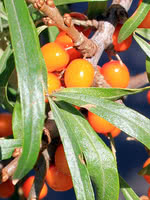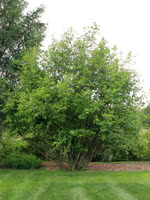Mon-Fri 9am - 5pm Mountain time
Sea Buckthorn (Seaberry) vs Green Alder
Hippophae rhamnoides l.
Alnus alnobetula subsp. crispa
SOLD OUT
Sea Buckthorn, aka Seaberry, is a nitrogen fixing shrub that produces attractive berries high in vitamin C.
While we can't confirm claims that the berries are effective in treating various ailments, many people believe consuming the berries helps with arthritis, infections, and asthma, among other things.
Sea Buckthorn plants have attractive pale silvery-green leaves, dense branches, and large thorns, people like to grow in ornamental hedges or as a first row in a shelterbelt.
Note: these plants typically reach maturity and make their sex easily known (females producing fruit) in their 3rd or 4th year of growth. Our seedlings are too young to identify their sex.
Green Alder is a native, cold-hardy shrub found in boreal forests, along slopes, and in open upland habitats. It fixes nitrogen in the soil, improving fertility and helping other plants grow, while its roots help stabilize slopes and disturbed ground. Fast to establish on poor soils, it is widely used in reclamation, restoration, and erosion control projects.
With its smooth grey bark and shiny green leaves, Green Alder often forms dense thickets that provide cover for birds and small mammals. Its seeds, buds, and catkins also supply food for wildlife. Green Alder is well suited for naturalization and ecological restoration.
Note: We use Green Alder for Alnus alnobetula subsp. crispa. This species is also known by many other common names, including Mountain Alder, Sitka Alder, and others. Please confirm the scientific name to ensure you are ordering the correct plant.
Sea Buckthorn (Seaberry) Quick Facts
Green Alder Quick Facts
In row spacing: 0.9 - 1.2 m (3 - 4 ft)
In row spacing: 0.9 m (3 ft)

